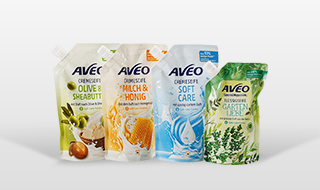 Tel: +86 188 2689 9458
Tel: +86 188 2689 9458
 Tel: +86 188 2689 9458
Tel: +86 188 2689 9458
source:other news release time:2022-11-14 Hits:

1. Single film:
It is required to be transparent, non-toxic, impermeable, with good heat sealing and bag making properties, heat and cold resistance, mechanical strength, grease resistance, chemical resistance and adhesion resistance. It can be prepared by extrusion blowing, extrusion tape casting, calendering, solvent tape casting and other methods.
The heat sealing performance of the monolayer film is not only related to the relative molecular weight distribution and molecular disproportionation of the resin, but also related to the process conditions during film preparation, such as temperature, cooling rate, blowing ratio, etc.
2. Aluminum foil:
99.5% pure electrolytic aluminum is melted and pressed into foil by calender, which is ideal as the base material for soft plastic packaging. It has good gas barrier, water vapor barrier, light shielding, thermal conductivity and shielding.
3. Vacuum evaporation aluminum film:
Under high vacuum, the metal with low boiling point, such as aluminum, is melted, vaporized and stacked on the plastic film on the cooling drum to form an aluminized film with good metallic luster. When the aluminum plating thickness reaches certain requirements, the oxygen resistance and moisture resistance of the substrate can be greatly improved. The substrate shall be corona treated and coated with sol.
4. Silicon coating:
It is also called ceramic coating. No matter how high the temperature and humidity are, the performance will not change. It is suitable for making high-temperature cooking bags. There are two kinds of coatings: one is silicon oxide SiOx, the smaller the X is, the better the barrier is; The second is Al2O3. The coating methods include physical evaporation and chemical evaporation.
5. Gluing (dry/wet) composite film:
Single layer films have certain advantages as well as inherent disadvantages. They are often difficult to meet a variety of packaging performance requirements. Multiple layers of different substrates can complement each other and give full play to their comprehensive advantages.
6. Extrusion coating composite film:
On an extruder, thermoplastic is streamed on the paper, foil, and plastic substrate to be covered through a T-shaped die, or the extruded resin is used as the intermediate binder, and other film substrates are pressed together while hot to form a sandwich type composite film.
In order to improve the composite fastness, it is necessary to conduct corona treatment and apply anchor paint. The extruded composite film can be reverse printed, the thickness of each layer can be precisely controlled, the residual amount of solvent is small, and the price is cheap.
7. Co extruded composite film:
Two or three extruders are used to use a common composite die to laminated several compatible thermoplastics to produce multilayer films or sheets. Co extruded composite film can only be printed on the front, not on the back.
It is difficult to control the thickness of each layer compared with dry composite film and extruded cast film. No adhesive and anchor paint are used, which is pollution-free and sanitary. Co extruded composite membrane has the lowest cost.
8. High barrier film:
It is a multilayer structure film. It can effectively prevent the infiltration of oxygen and other gases, thus causing the propagation of microorganisms; Prevent the wrapped articles from oxidation; Prevent the outflow of fragrance, solvent, etc.
The commonly called high barrier and high-strength materials, such as EVAL, PVDC, PET, PAN, self PA, can be made into packaging films, which can significantly extend the shelf life of food, or replace the traditional rigid packaging materials with good barrier performance.
Read recommendations:
Hot Sale BPA Free Plastic Drink Juice Fruit Liquid Packaging Stand Up Bag Spout Pouch
mulberry mini pouch with handle Vendor
Introduce you how to use Zipper Vacuum Sealer Bag.zipper vacuum sealer bag
Analysis of the material of the food packaging bag.snack food bags wholesale
Popular recommendation
Wholesale High Barrier Plastic Stand Up Flat Bottom Pet Dog Food Packaging Bag
China Factory Baby Complementary Food Spout Pouch Baby Food Fruit Puree Bag With Spout Packaging Bag
PET food bag
ordering flexible packaging film roll Manufacturing
spout pouch packaging Factory
Spout pouch flexibility price
Flexible packaging film roll Packaging distributors
Spout pouch distributors
stand up spout pouch wholesale
reusable Snack food bag Processing
Juice Pouch Bags: The Ultimate Guide
Composition of liquid bags
Test standards for frozen food packaging.petco free dog food bag Manufacturing
The development trend of domestic food packaging.vanishing coff packaging bag Processing
The difference between aluminum foil bag and composite bag and vacuum packaging bag
Types of coffee bag
Classification of liquid bags
The application of vacuum in food packaging and freezing and drying industry
The origin of aluminum foil bags!disposable aluminum foil bag
Human care in food packaging
Why do Vacuum packing bags wrinkle?food vacuum bag
Development of Packaging Industry.bag in box packaging
The origin of aluminum foil bags!aluminum foil bags for grilling Manufacturing
What are the conditions for food packaging?stand up pouches for food package
Learn about the main ingredients of plastic bags.pet food packaging bag
Why are there no qs marks on many food packaging bags?bag in box 3L,5L,10L
Advantages of Bag in Box Packaging.5l bag in box
recyclable spout pouches.Non woven packaging bags
High -temperature steaming bag rupture analysis
Advantages and characteristics of anti -static bags.food packaging supply companies